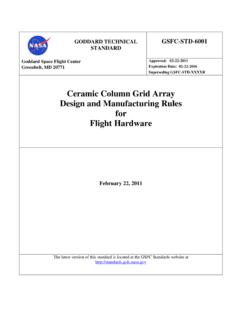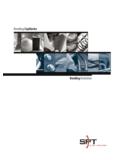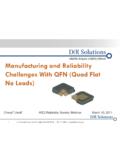Transcription of Column Grid Array: A Modified COTS Approach for Area Array ...
1 Column grid Array : A Modified COTS Approach for Area Array Packaging of Military and Space Electronics William E. Davis And Russell T. winslow Introduction Package to board interconnection has been accomplished using many different methods over the years. Initially, pin-through-hole (PTH) lead attachment dominated the industry with integrated circuit packages that were rectangular in shape and had rather large leads extending from the long side of the rectangle. These devices were limited in lead count, but provided very rugged interconnection between the package and the board. For applications where high lead counts were needed, pin- grid - Array devices were developed; these devices had an Array of pins covering the bottom surface of the device and these pins were inserted into the board and soldered in place.
2 PTH technology was replaced by surface mount technology (SMT) as a means of increasing the number of leads around the perimeter of the devices and also to improve the automation of the process for attaching the devices to the boards. This technology was very amenable to pick and place automation for board assembly and it has dominated the industry for the past 15 years. As SMT technology evolved, the desire to increase lead counts led to finer pitched leads around the perimeter and larger packages to accommodate the high lead counts. Note: Ironically the silicon chips were getting smaller as the packages were getting larger. The quad flat pack (QFP) has become an industry standard and through the use of flexible, gull wing leads, the devices have proven to be very reliable in thermal cycling environments.
3 This packaging Approach provides everything that is needed except for one critical item the lead count is limited (~300 leads) by the external dimensions of the package. grid Array Packaging In the early 1990 s, a revolution in package design took place that breaks through the barriers established by perimeter leaded packaging. This new packaging technology is known as ball grid Array (BGA) technology and it has enabled designs that can achieve lead counts of over 1000 input/output points. It also has enabled the evolution of chip-scale packaging, where the package surface area approaches the size of the chip. A typical BGA package is shown in Figure 1. Figure 1. Typical BGA Package A BGA package consists of a silicon chip attached to the surface of a substrate, usually FR4 laminate, but ceramic is used for high reliability applications.
4 The substrate has printed circuitry that provides interconnect points for the silicon chip on the top surface, connected by fine pitch traces to an Array of pads on the bottom surface. The pads on the bottom surface have solder spheres attached and they are the interconnect points for the package to the board. The solder spheres are typically eutectic (63Pb/37Sn), however, high lead (90Pb/10Sn) balls are sometimes used. In addition to the high lead count, this technology affords many other benefits that include ease of handling, simplified device attachment and overall cost effectiveness compared to fine pitch, perimeter leaded devices. BGA is rapidly becoming the industry standard for packaging and it is being used for semiconductor devices, connectors and silicon chip interconnection.
5 As this revolution in packaging takes place, there is a compromise in thermal cycling capability that is also being accepted by the industry. A perimeter leaded device with gull wings can be subjected to many thermal cycles without encountering stresses due to thermal coefficient of expansion (TCE) mismatch between the board and the device. BGA packages are connected with a rigid structure of solder spheres (oval shaped after reflow) and provide very little compliance between the package and the board. When the device is operated, waste heat builds up and a temperature differential between the device and the board is created. The temperature differential, as well as the differences in CTE between the device and the board will lead to stresses in the solder sphere attachment points.
6 For commercial temperature ranges (0 C to 100 C) and life cycle requirements (<2000 cycles), the stresses have been shown to be acceptable. However, applications that require broader temperature ranges ( , -40 C to +125 C), extended life cycles (>2000 cycles) and possibly the use of ceramic substrates ( , Motorola PowerPC ), BGA technology is high risk. Column grid Array : A Flexible Solution A successful solution to the BGA compromise is to utilize a flexible Column in place of the solder spheres. Figure 2 shows the difference between a BGA package with solder spheres and a Column grid Array (CGA) leads. Figure 2. Solder Spheres and Solder Columns CGA provides a more robust design for thermal cycling environments and it accomplishes this in two ways: the leads are designed to have a lower stiffness than a solder sphere and they also have a higher offset distance between the device and the board.
7 These two features enable the leads to flex with less stress as the dimensional expansion between the device and the board varies. The dimensional offset will reduce the stress in the part by the square of the distance between the device and the board. Typical solder columns are ~ inches and a typical solder spheres (eutectic) will have an offset after (reflow) of ~ to inches1. This change in offset reduces the stresses in the leads by a factor of 4 to 16. Additional reductions are achieved because the solder columns are smaller in diameter and, hence have a lower overall stiffness. The technology for solder columns has been available for over 15 years and there are two basic Column products that are used. The first is a high Pb casting of solder that has a height of or and a diameter of 2.
8 This product is used by IBM Microelectronics and it is not commercially available to the industry. The second product is a high Pb solder wire that utilizes a copper ribbon wrapped in a spiral around the diameter and length of the Column . The copper spiral is held in place via a reflow of eutectic solder. The product is cut in lengths of or and it has a diameter of . Figure 3 shows a cross section of the wire form solder Column . The copper ribbon can be visibly seen in this cross section. Figure 3. Solder Column Wire Cross Section 1 A Practical Comparison of Surface Mount Assembly for Ball grid Array Components, Paul Mescher and Giana Phelan, IBM Microelectronics, Endicott, NY 2 Card Assembly and Reliability of 44mm Ceramic Solder Column Array Modules, Giana Phelan, Michael Welch, Show-Chi Wang and Marie Cole, IBM Microelectroncis The copper ribbon provides an added level of reliability that enables a conductive path along the length even if the solder fails.
9 The wire solder Column product is available commercially from Six Sigma Services as an aftermarket attachment to ball grid Array devices. Reliability of CGA vs BGA The CGA concept for interconnect attachment is inherently more reliable than BGA and should be considered for any BGA packaging applications where harsh thermal environments exist and where long life is essential. There are numerous tests and investigations that have been conducted to prove this and as an example Table 1 shows data that was generated by Motorola in support of the PowerPC family of microprocessors. In this investigation, ceramic BGA and CGA products were compared at commercial temperature ranges (0 C to 100 C) and at extended temperature ranges (-40 C to 100 C)3.
10 Table 1 Temperature Cycle Data for BGA and CGA Devices Package/Test Condition F=100ppm (95 % CI) F = 1000ppm F = 50 % Failure BGA/0 C to 100 C 273 298 450 CGA/0 C to 100 C 937 1073 2057 CGA/-40 C to 125 C 462 502 747 The tests were performed on a 32mm, 625 lead package with the devices mounted to a printed circuit board. The BGA package used a high Pb solder sphere, which provides a higher standoff, higher strength and a higher fatigue life than a typical eutectic solder sphere4. As shown in the data above, the expected life of a CGA package will range from to times greater than a BGA package at commercial temperature ranges. At temperature ranges beyond commercial levels the BGAs will have severely limited life and the use of eutectic solder spheres will also lead to reduced life.






